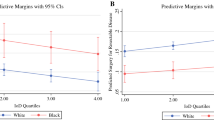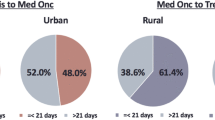Abstract
Background
Disparities in pancreatic cancer outcomes between black and white patients are well documented. This study aimed to use a more novel index to examine the impact of racial segregation on the diagnosis, management, and outcomes of pancreatic cancer in black patients compared with white patients.
Methods
Black and white adults with pancreatic cancer in urban counties were identified using data from the 2018 submission of the Surveillance, Epidemiology and End Results (SEER) Program and the 2010 Census. The racial index of dissimilarity (IoD), a validated proxy of racial segregation, was used to assess the evenness with which whites and blacks are distributed across census tracts in each county. Multivariate Poisson regression was performed, and stepwise models were constructed for each of the outcomes. Overall survival was studied using the Kaplan–Meier method.
Results
The study enrolled 60,172 adults with a diagnosis of pancreatic cancer between 2005 and 2015. Overall, the black patients (13.8% of the cohort) lived in more segregated areas (IoD, 0.67 vs 0.61; p < 0.05). They were less likely to undergo surgery for localized disease (relative risk [RR], 0.80; 95% confidence interval [CI], 0.76–0.83) and more frequently had a diagnosis of advanced-stage disease (RR, 1.09; 95% CI, 1.01–1.19) with increasing segregation. They also had shorter survival times (9.8 vs 11.4 months; p < 0.05).
Conclusions
Disparities in advanced-stage disease at diagnosis, surgery for localized disease, and overall survival are directly related to the degree of residential segregation, a proxy for structural racism. In searching for solutions to this problem, it is important to account for the historical marginalization of black Americans.





Similar content being viewed by others
References
Permuth JB, Clark Daly A, Jeong D, et al. Racial and ethnic disparities in a state-wide registry of patients with pancreatic cancer and an exploratory investigation of cancer cachexia as a contributor to observed inequities. Cancer Med. 2019;8:3314–24. https://doi.org/10.1002/cam4.2180.
Abraham A, Al-Refaie WB, Parsons HM, Dudeja V, Vickers SM, Habermann EB. Disparities in pancreas cancer care. Ann Surg Oncol. 2013;20:2078–87. https://doi.org/10.1245/s10434-012-2843-z.
Nipp R, Tramontano AC, Kong CY, et al. Disparities in cancer outcomes across age, sex, and race/ethnicity among patients with pancreatic cancer. Cancer Med. 2018;7:525–35. https://doi.org/10.1002/cam4.1277.
Moaven O, Richman JS, Reddy S, Wang T, Heslin MJ, Contreras CM. Healthcare disparities in outcomes of patients with resectable pancreatic cancer. Am J Surg. 2019;217:725–31. https://doi.org/10.1016/j.amjsurg.2018.12.007.
U.S. Cancer Statistics Working Group. U.S. Cancer Statistics Data Visualizations Tool, based on November 2018 submission data (1999–2016). Washington, DC: U.S. Department of Health and Human Services, Centers for Disease Control and Prevention, and National Cancer Institute.
American Cancer Society. Cancer Facts & Figures 2020. Atlanta: American Cancer Society; 2020.
The Aspen Institute Roundtable on Community Change. Structural Racism and Community Building, 2004. https://assets.aspeninstitute.org/content/uploads/files/content/docs/rcc/aspen_structural_racism2.pdf. Accessed 11 Oct 2019.
Berlin I. The making of African America: the four great migrations, vol, 9. New York: The Penguin Group; 2010. https://doi.org/10.1215/15476715-1599594.
Louis Gates H Jr. Stony the road: reconstruction, white supremacy, and the rise of Jim Crow. New York: Penguin Press; 2019.
Mitchell B, Franco J. HOLC redlining maps: the persistent structure of segregation and economic inequality. Natl Community Reinvestment Coalit; 2018. ncrc.umich.edu/about-ncrc. Accessed 23 Oct 2019.
Rothstein R. The color of law: a forgotten history of how our government segregated America. 1st ed. New York: Liveright Publishing Corporation, a division of W.W. Norton & Company; 2017.
Protections Against Discrimination and Other Prohibited Practices. Washington, DC: Federal Trade Commission.
Division CR. Fair Housing Act. Washington, DC: Department of Justice.
Villalobos PM. The Civil Rights Restoration Act of 1987: revitalization of Title IX. Marquette Sport Law J. 1990;1:149–69.
Krimmel J, comments F, thank Fernando Ferreira I, et al. Persistence of prejudice: estimating the long-term effects of redlining. Persistence Prejud Estim Long Term Eff Redlining. 2018 (October 2016). https://www.federalreserve.gov/consumerscommunities/cra_about.htm.
Aaronson D, Hartley D, Mazumder B. The effects of the 1930s HOLC “Redlining” maps. Fed Reserv Bank Chicago. 2019; Working paper (February).
Haas JS, Earle CC, Orav JE, Brawarsky P, Neville BA, Williams DR. Racial segregation and disparities in cancer stage for seniors. J Gen Intern Med. 2008;23:699–705. https://doi.org/10.1007/s11606-008-0545-9.
Kershaw KN, Diez Roux AV, Burgard SA, Lisabeth LD, Mujahid MS, Schulz AJ. Metropolitan-level racial residential segregation and black–white disparities in hypertension. Am J Epidemiol. 2011;174:537–45. https://doi.org/10.1093/aje/kwr116.
Greer S, Kramer MR, Cook-Smith JN, Casper ML. Metropolitan racial residential segregation and cardiovascular mortality: exploring pathways. J Urban Heal. 2014;91:499–509. https://doi.org/10.1007/s11524-013-9834-7.
Anthopolos R, Kaufman JS, Messer LC, Miranda ML. Racial residential segregation and preterm birth: built environment as a mediator. Epidemiology. 2014;25:397–405. https://doi.org/10.1097/ede.0000000000000079.
Hayanga AJ, Zeliadt SB, Backhus LM. Lung cancer mortality and residential segregation in the United States. JAMA Surg. 2013;148:37–42. https://doi.org/10.1016/j.jamcollsurg.2011.06.278.
Dai D. Black residential segregation, disparities in spatial access to health care facilities, and late-stage breast cancer diagnosis in metropolitan Detroit. Heal Place. 2010;16:1038–52. https://doi.org/10.1016/j.healthplace.2010.06.012.
Haas JS, Earle CC, Orav JE, et al. Racial segregation and disparities in breast cancer care and mortality. Cancer. 2008;113:2166–72. https://doi.org/10.1002/cncr.23828.
Russell E, Kramer MR, Cooper HLF, Thompson WW, Arriola KRJ. Residential racial composition, spatial access to care, and breast cancer mortality among women in Georgia. J Urban Heal. 2011;88:1117–29. https://doi.org/10.1007/s11524-011-9612-3.
National Cancer Institute, DCCPS SRP. Surveillance, Epidemiology, and End Results (SEER) Program (www.seer.cancer.gov) research data (1975–2016). Bethesda, MD: NCI.
Murphy MM, Simons JP, Ng SC, et al. Racial differences in cancer specialist consultation, treatment, and outcomes for locoregional pancreatic adenocarcinoma. Ann Surg Oncol. 2009;16:2968–77. https://doi.org/10.1245/s10434-009-0656-5.
Quinn LM. Assumptions and limitations of the census bureau methodology ranking racial and ethnic residential segregation in cities and metro areas. 2004;(October):1–20.
U.S. Census Bureau. Census regions and divisions of the United States. 2010:1–2. https://www2.census.gov/geo/pdfs/maps-data/maps/reference/us_regdiv.pdf. Accessed 13 Oct 2019.
Bureau USC. Appendix B. Measures of residential segregation. Racial Ethn Resid Segreg United States 1980–2000. 2000;(1988):119–23.
Hong S-Y, O’Sullivan D. Seg Package. 2019.
Edge SB, Byrd DR, Compton CC, Fritz AG, Greene FL, Andy Trotti I. AJCC Cancer Staging Manual. Basel, Switzerland: Springer; 2017. https://doi.org/10.1007/978-3-319-40618-3.
Stata Statistical Software: Release 14.
Governing. Residential Segregation Data for U.S. Metro Areas.
Johnson AM, Johnson A, Hines RB, Bayakly R. The effects of residential segregation and neighborhood characteristics on surgery and survival in patients with early-stage non-small cell lung cancer. Cancer Epidemiol Biomarkers Prev. 2016;25:750–8. https://doi.org/10.1158/1055-9965.epi-15-1126.
Warner ET, Gomez SL. Impact of neighborhood racial composition and metropolitan residential segregation on disparities in breast cancer stage at diagnosis and survival between black and white women in California. J Community Heal. 2010;35:398–408. https://doi.org/10.1007/s10552-018-1027-y.
Zhou Y, Bemanian A, Beyer KMM. Housing discrimination, residential racial segregation, and colorectal cancer survival in southeastern Wisconsin. Cancer Epidemiol Biomarkers Prev. 2017;26:561–8. https://doi.org/10.1158/1055-9965.epi-16-0929.
Warner ET, Gomez SL. Impact of neighborhood racial composition and metropolitan residential segregation on disparities in breast cancer stage at diagnosis and survival between black and white women in California. J Community Health. 2010;35:398–408. https://doi.org/10.1007/s10900-010-9265-2.
Mobley LR, Scott L, Rutherford Y, Kuo TM. Using residential segregation to predict colorectal cancer stage at diagnosis: two different approaches. Ann Epidemiol. 2017;27:10–19. https://doi.org/10.1016/j.annepidem.2016.11.008.
Beaulieu M, Continelli T. Benefits of segregation for white communities: a review of the literature and directions for future research. J African Am Stud. 2011;15:487–507. https://doi.org/10.1007/s12111-011-9158-1.
Sarrazin MSV, Rosenthal GE. Finding pure and simple truths with administrative data. J Am Med Assoc. 2012;307:1433–5.
Chetty R, Hendren N, Katz LF. The effects of exposure to better neighborhoods on children: new evidence from the moving to opportunity experiment. Am Econ Rev. 2016;106:855–902. https://doi.org/10.1257/aer.20150572.
Author information
Authors and Affiliations
Corresponding author
Ethics declarations
Disclosure
There are no conflicts of interest.
Additional information
Publisher's Note
Springer Nature remains neutral with regard to jurisdictional claims in published maps and institutional affiliations.
Electronic supplementary material
Below is the link to the electronic supplementary material.
Rights and permissions
About this article
Cite this article
Blanco, B.A., Poulson, M., Kenzik, K.M. et al. The Impact of Residential Segregation on Pancreatic Cancer Diagnosis, Treatment, and Mortality. Ann Surg Oncol 28, 3147–3155 (2021). https://doi.org/10.1245/s10434-020-09218-7
Received:
Accepted:
Published:
Issue Date:
DOI: https://doi.org/10.1245/s10434-020-09218-7




